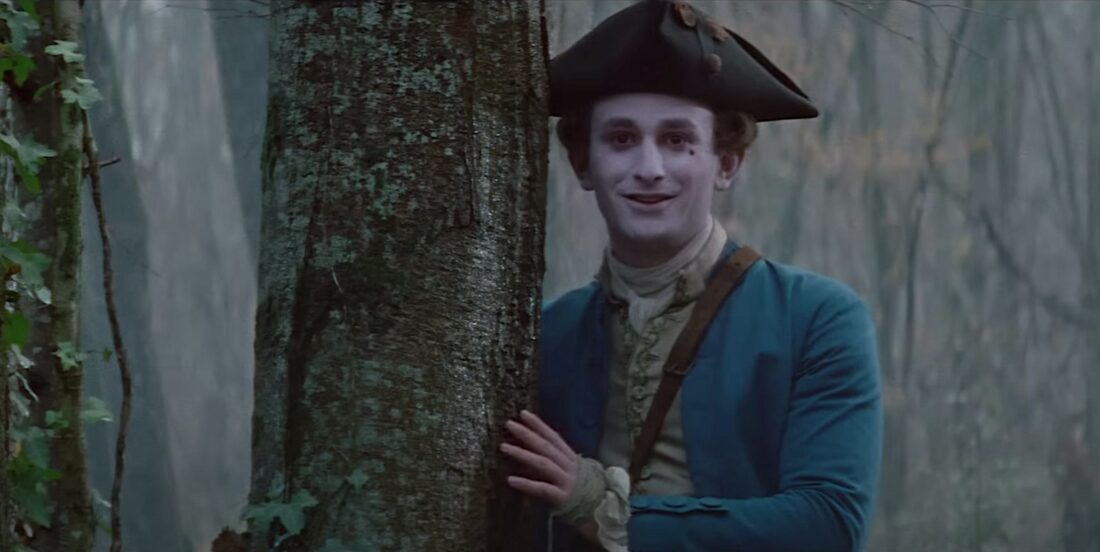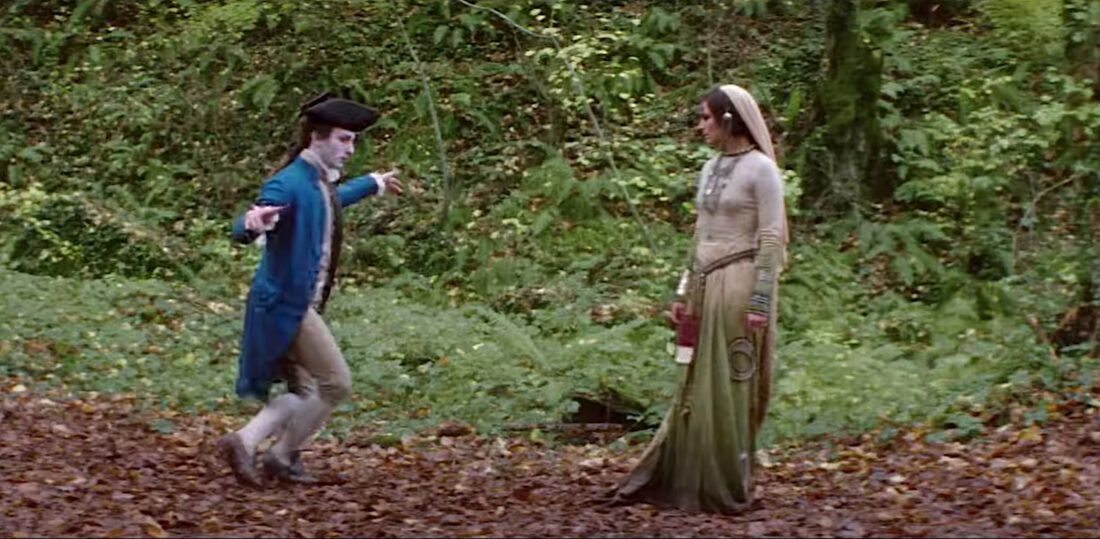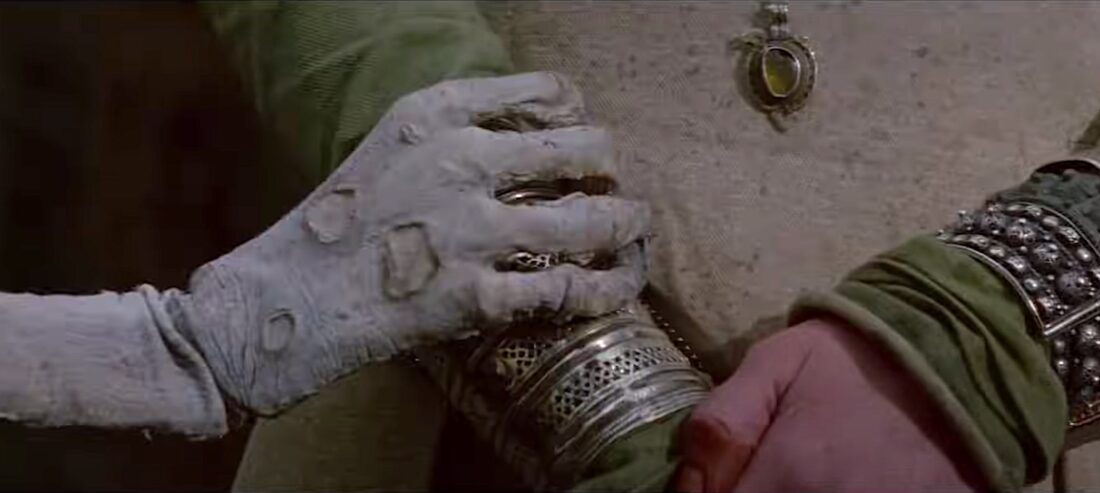Over the last two weeks I’ve seen Handling the Undead, a slow, sad film about motherhood and grief, with zombies in it, and The Devil’s Bath, a slow, sad movie about motherhood and depression, with some folk horror trappings in it. In both films children and animals die gruesome deaths.
Now we come to The Vourdalak, a faster-paced story about fear of immigration, fear of contamination, and the fear of queerness, with vourdalaks in it. An animal and a child die gruesome deaths.
But wait, perhaps you’re asking yourself what a vourdalak is? It’s a revenant—vampire-like, though its name seems to come from a Slavic word that was used for a creature more like a werewolf than our modern idea of a vampire. In 1839 Aleksey Konstantinovich Tolstoy (Leo Tolstoy’s second cousin!) wrote a novella called The Family of the Vourdalak seemingly drawing on Slavic myths, and that novella is the basis for The Vourdalak, directed by Adrien Beau, who co-wrote the screenplay with Hadrien Bouvier. In Tolstoy’s version (published 20 years after John Polidori’s The Vampyre, and almost 60 years before Bram Stoker’s Dracula) the vourdalak thirsts for blood, but specifically the blood of its loved ones, and they’re pretty impossible to (re)kill; the movie adds the beautiful detail that they wander around sucking on their burial shrouds like babies with blankets, which means they’re preceded by an ominous slurping sound.
If you don’t think a “slurping sound” can be “ominous”, The Vourdalak will be only too happy to demonstrate why you’re wrong.
So that’s what this new movie has in common with the prior two, but the big glaring difference is that while those two movies were both very good, and I’m glad I watched them, The Vourdalak is fun. At least, it’s fun for a while, if you have a fairly sick sense of humor and you love weird, startling vampire movies.
The film opens abruptly, with a pounding at a door in the dark. The Marquis Jacques Antoine Saturnin d’Urfé, an emissary of the French Court, has been beset by bandits who murdered his guide and took his horse and supplies. The guard on the other side of the door is more concerned with whether or not they were “Turks” than with the plight of M. d’Urfé, and he sends him on his way down the road. There’s a gentleman named Gorcha, he can give the Marquis a horse if the horrors of the forest don’t kill him first.

The Marquis somehow survives the night, and on the way to Gorcha’s house runs into a mysterious dancing lady (Ariane Labed) and, a little further down the path, a second mysterious dancing lady who turns out to be a young man in drag. He (the movie only uses “he” pronouns for this character, but things get complicated) turns out to be the younger son of Gorcha, Piotr (Vassili Schneider). The other lady was Gorcha’s daughter, Sdenka. Once they reach the estate, d’Urfé meets Anja (Claire Duburcq), Gorcha’s daughter-in-law, and his grandson Vlad (Gabriel Pavie). Finally, his elder son, Jegor (Grégoire Colin), returns from hunting down the band of Turks that attacked the village.
But where, then, is Gorcha?
Apparently, he went off to fight the Turks too, even though he’s very, very old. And he warned Piotr and Sdenka that if he’s away longer than 6 days that means he’s a vourdalak and they have to kill him. And guess what else? Today is DAY SIX.
For the next hour or so, the film is a delightful horror-farce, where one half of an Eastern European family knows they have a bloodsucking monster in their midst, the other half absolutely denies that despite plenty of evidence to the contrary, and meanwhile an elegant French courtier stands in the corner trying to figure out how to survive all this. (Usually his defense is to throw witticisms and court tales around to amuse people who are absolutely not going to be amused by him.) The more I’ve thought about it, the best way I can describe it is if you dropped an aristocratic French version of Tony Hale’s Buster Bluth into a Hammer Horror. And Kacey Mottet Klein is hilarious in the role—until he isn’t. Because at a certain point a monster movie has to unleash its monster, and The Vourdalak becomes a creepy, bloody, often upsetting horror movie—one that’s also about the fear of outsiders and queerness, as I said above. Because like all good horror, The Vourdalak is about something, not just mindless entertainment.
The original story is similar to a Universal Horror Picture: stranger comes to a rural town, is warned about monsters, scoffs at backward superstition, encounters said monsters who are totally real, and lives to tell the tale, years later, to other “civilized” folk. The film makes a lot of small tweaks to the source material—in the story the Marquis d’Urfé doesn’t spend as much time with the family, and the elder brother is the one who believes in vourdalaks. (Most fun is that the film changes the elder brother’s name to Jegor, and names his son Vlad.) If you have a well-developed sense of gallows humor, it’s, uhhh, amusing to watch as the people in power ignore an obvious threat in their midst, leaving it to the most vulnerable members of the family to try to fight back and save everyone.
But what I find really rewarding about the film, as I think about it, is that it turns a simple horror tale into a complex story about Otherness, and especially queerness.

The Marquis d’Urfé is an Other, and seems like kind of a fop. But he’s not a wimp, and he has a compassionate nature underneath all his finery. He puts his pale makeup and false mole on each morning, dresses in his bright blue waistcoat, and treats Old Gorcha’s family like individuals worthy of respect, even when their beliefs are strange to him. After a few moments of caddishness, he accepts Sdenka and Piotr as they are. He keeps a respectful demeanor while they practice their various religious rituals, both the ones that to my eyes read as Eastern Catholicism and the ones that seem a bit more occult, even though, in the original story, the Marquis is a faithful devotee of the Enlightenment and practices no religion. And going in the other direction, Jegor treats the Marquis as an honored guest even though their cultures are different… for a while. At a certain point, of course, it’s easier to blame the stranger for all the misfortune falling on his family, and Jegor unwittingly becomes as much of a threat to everyone as the vourdalak himself. This element, along with Piotr’s implied queerness, and Sdenka’s yearning for independence and adventure, are all inventions of the movie, and they really take the story to a more interesting level.
I wasn’t sure I could be really surprised by a vampire story at this point, but by going back further than Dracula, and mining a different source material, Beau is able to create a movie where you can never be sure of the rules. The vourdalak has certain powers, but he also has a musket. He’s vile and destructive, but he loves his family and wants to keep them together. Perhaps best of all, the portrayal of the vourdalak is somehow hilarious and terrifying at once, but, again, to say much more will spoil the very surprises I’m talking about, so I’ll dig into the film a bit more in a couple of full-spoiler paragraphs below.
First, let me send anyone who hasn’t seen it yet with a recommendation that you seek it out and try to see it in a theater if it’s safe. This is a unique, inventive movie with some legitimately scary moments and an actual heart under all of its frockcoats and fur cloaks. People love to throw the word “weird” around, but this movie is actually weird.
And now, spoilers! Grab your burial shroud and get outta here if you want to go into the movie cold as death.

I find it fascinating that in the last few months, I’ve seen two vastly different movies with avenging queer people who seem to gain almost supernatural power from their queerness. One was in Monkey Man (which, if you haven’t seen Monkey Man, GET ON THAT. Right after you see The Vourdalak.) and the other was in the indie sci-fi comedy Mars, a movie I got to see at Tribeca Film Festival (review coming soon!). These two unlikely compatriots are joined, to an extent, by The Vourdalak.
When we first meet Piotr, he’s dressed very much like his sister. d’Urfé addresses him as “madame” before he gets a closer look at his face and amends to “sir”. We soon learn that Piotr is only free to dress in a confirming way because his father and elder brother are gone. Each time he tries to stand against them they throw some variation of a slur at him, and he backs down again, clearly terrified of what they’ll do to him—I assume because they’ve done terrible things before. But when he does finally strike out against his old man/revenant, he does so in full glorious makeup and gorgeous flower crown. That the attempt fails doesn’t really matter. This is a dark, dark movie, and part of the point of it is that any attempt to fight the evil is bound to fail. But Piotr goes down swinging, he goes down as his true self.
Later, the film’s relationship to queerness is further complicated by the vourdalak himself. In the story, d’Urfé returns to Gorcha’s home months after the initial encounter. He finds Sdenka still there, and seemingly fine, and she entices him to stay in her room with her. At a certain point he realizes he’s been enchanted, sees that he’s making out with a rotting vourdalak, and sees Old Gorcha and his eldest son waiting outside to pounce on him. In the film, the scene begins the same way, until it’s revealed that Old Gorcha himself has enchanted and seduced him. But then, another turn: the vourdalak explicitly says that he’s fallen in love with d’Urfé, and if he’d met him sooner, his entire life might have gone differently. Adrien Beau has taken a standard vampire story, and, in addition to musing on “the other” as an idea, he’s created a dark exploration of generations of repression and fear, and how that repression destroys everything it touches.
Along the same lines, the film takes d’Urfé, who could have just been a silly fop caricature, and allows him to be a real person. When he sees little Vlad stumbling off into the woods in search of his grandfather, he does his best to protect the boy. When Piotr is in anguish over having to kill his dog on Old Gorcha’s orders, it’s d’Urfe, not Sdenka, who finds him to comfort him. Faced with his own imminent death, d’Urfé gives his map and horse to Sdenka so she can be free and make her own life.
As in Piotr’s case, this act of hope turns out to be in vain, but who cares? Better to die with hope in your heart, if you’re going to die anyway.

